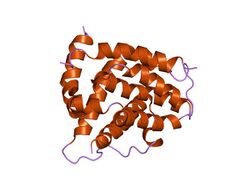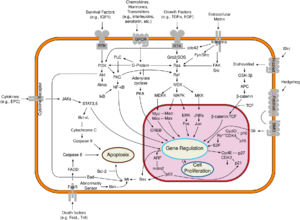Biology:Bcl-2-associated death promoter
 Generic protein structure example |
| Pro-apoptotic Bcl-2 protein, BAD | |||||||||
|---|---|---|---|---|---|---|---|---|---|
 complex of bcl-xl with peptide from bad | |||||||||
| Identifiers | |||||||||
| Symbol | Bcl-2_BAD | ||||||||
| Pfam | PF10514 | ||||||||
| InterPro | IPR018868 | ||||||||
| |||||||||
The BCL2 associated agonist of cell death[1] (BAD) protein is a pro-apoptotic member of the Bcl-2 gene family which is involved in initiating apoptosis. BAD is a member of the BH3-only family,[2] a subfamily of the Bcl-2 family. It does not contain a C-terminal transmembrane domain for outer mitochondrial membrane and nuclear envelope targeting, unlike most other members of the Bcl-2 family.[3] After activation, it is able to form a heterodimer with anti-apoptotic proteins and prevent them from stopping apoptosis.
Mechanism of action
Bax/Bak are believed to initiate apoptosis by forming a pore in the mitochondrial outer membrane that allows cytochrome c to escape into the cytoplasm and activate the pro-apoptotic caspase cascade. The anti-apoptotic Bcl-2 and Bcl-xL proteins inhibit cytochrome c release through the mitochondrial pore and also inhibit activation of the cytoplasmic caspase cascade by cytochrome c.[4]
Dephosphorylated BAD forms a heterodimer with Bcl-2 and Bcl-xL, inactivating them and thus allowing Bax/Bak-triggered apoptosis. When BAD is phosphorylated by Akt/protein kinase B (triggered by PIP3), it forms the BAD-(14-3-3) protein heterodimer. This leaves Bcl-2 free to inhibit Bax-triggered apoptosis.[5] BAD phosphorylation is thus anti-apoptotic, and BAD dephosphorylation (e.g., by Ca2+-stimulated Calcineurin) is pro-apoptotic. The latter may be involved in neural diseases such as schizophrenia.[6]
Interactions

Bcl-2-associated death promoter has been shown to interact with:
- BCL2L1[7][8][9][10][11][12][13][14][15][16][17]
- BCL2A1[7][18]
- BCL2L2[7][11][18][19]
- Bcl-2[7][13]
- MCL1[7][18]
- S100A10[20]
- YWHAQ[7][20] and
- YWHAZ[21]
See also
References
- ↑ "BAD BCL2 associated agonist of cell death [Homo sapiens (Human)] - Gene - NCBI". https://www.ncbi.nlm.nih.gov/gene/572#gene-expression.
- ↑ "The proapoptotic BH3-only protein BAD transduces cell death signals independently of its interaction with Bcl-2". Cell Death Differ. 9 (11): 1240–7. 2002. doi:10.1038/sj.cdd.4401097. PMID 12404123.
- ↑ "Interference of BAD (Bcl-xL/Bcl-2-associated death promoter)-induced apoptosis in mammalian cells by 14-3-3 isoforms and P11". Mol. Endocrinol. 11 (12): 1858–67. 1997. doi:10.1210/mend.11.12.0023. PMID 9369453.
- ↑ Helmreich, E.J.M. (2001) The Biochemistry of Cell Signalling, pp. 238-43
- ↑ E.J.M. (2001) The Biochemistry of Cell Signalling, pp. 242
- ↑ Foster, T.C. et al. (2001) J. Neurosci. 21, 4066-4073, "Calcineurin Links Ca++ Dysregulation with Brain Aging"(
- ↑ 7.0 7.1 7.2 7.3 7.4 7.5 "Differential targeting of prosurvival Bcl-2 proteins by their BH3-only ligands allows complementary apoptotic function". Mol. Cell 17 (3): 393–403. February 2005. doi:10.1016/j.molcel.2004.12.030. PMID 15694340.
- ↑ "Survival function of protein kinase C{iota} as a novel nitrosamine 4-(methylnitrosamino)-1-(3-pyridyl)-1-butanone-activated bad kinase". J. Biol. Chem. 280 (16): 16045–52. April 2005. doi:10.1074/jbc.M413488200. PMID 15705582.
- ↑ "BAD partly reverses paclitaxel resistance in human ovarian cancer cells". Oncogene 17 (19): 2419–27. November 1998. doi:10.1038/sj.onc.1202180. PMID 9824152.
- ↑ "Development of a high-throughput fluorescence polarization assay for Bcl-x(L)". Anal. Biochem. 307 (1): 70–5. August 2002. doi:10.1016/S0003-2697(02)00028-3. PMID 12137781.
- ↑ 11.0 11.1 "The anti-apoptotic molecules Bcl-xL and Bcl-w target protein phosphatase 1alpha to Bad". Eur. J. Immunol. 32 (7): 1847–55. July 2002. doi:10.1002/1521-4141(200207)32:7<1847::AID-IMMU1847>3.0.CO;2-7. PMID 12115603.
- ↑ "Human homologue of S. pombe Rad9 interacts with BCL-2/BCL-xL and promotes apoptosis". Nat. Cell Biol. 2 (1): 1–6. January 2000. doi:10.1038/71316. PMID 10620799.
- ↑ 13.0 13.1 "Bad, a heterodimeric partner for Bcl-XL and Bcl-2, displaces Bax and promotes cell death". Cell 80 (2): 285–91. January 1995. doi:10.1016/0092-8674(95)90411-5. PMID 7834748.
- ↑ "Rationale for Bcl-xL/Bad peptide complex formation from structure, mutagenesis, and biophysical studies". Protein Sci. 9 (12): 2528–34. Dec 2000. doi:10.1110/ps.9.12.2528. PMID 11206074.
- ↑ "BAD/BCL-[X(L)] heterodimerization leads to bypass of G0/G1 arrest". Oncogene 20 (33): 4507–18. July 2001. doi:10.1038/sj.onc.1204584. PMID 11494146.
- ↑ "Synergistic anti-apoptotic activity between Bcl-2 and SMN implicated in spinal muscular atrophy". Nature 390 (6658): 413–7. November 1997. doi:10.1038/37144. PMID 9389483. Bibcode: 1997Natur.390..413I.
- ↑ "PCNA interacts with hHus1/hRad9 in response to DNA damage and replication inhibition". Oncogene 19 (46): 5291–7. November 2000. doi:10.1038/sj.onc.1203901. PMID 11077446.
- ↑ 18.0 18.1 18.2 "Underphosphorylated BAD interacts with diverse antiapoptotic Bcl-2 family proteins to regulate apoptosis". Apoptosis 6 (5): 319–30. October 2001. doi:10.1023/A:1011319901057. PMID 11483855.
- ↑ "Survival activity of Bcl-2 homologs Bcl-w and A1 only partially correlates with their ability to bind pro-apoptotic family members". Cell Death Differ. 6 (6): 525–32. June 1999. doi:10.1038/sj.cdd.4400519. PMID 10381646.
- ↑ 20.0 20.1 "Interference of BAD (Bcl-xL/Bcl-2-associated death promoter)-induced apoptosis in mammalian cells by 14-3-3 isoforms and P11". Mol. Endocrinol. 11 (12): 1858–67. November 1997. doi:10.1210/mend.11.12.0023. PMID 9369453.
- ↑ "The proapoptotic protein Bad binds the amphipathic groove of 14-3-3zeta". Biochim. Biophys. Acta 1547 (2): 313–9. June 2001. doi:10.1016/S0167-4838(01)00202-3. PMID 11410287.
Further reading
- "HIV/SIV escape from immune surveillance: focus on Nef". Curr. HIV Res. 2 (2): 141–51. 2004. doi:10.2174/1570162043484924. PMID 15078178.
- "p53 and Bad: remote strangers become close friends". Cell Res. 17 (4): 283–5. 2007. doi:10.1038/cr.2007.19. PMID 17404594.
- "Bad, a heterodimeric partner for Bcl-XL and Bcl-2, displaces Bax and promotes cell death". Cell 80 (2): 285–91. 1995. doi:10.1016/0092-8674(95)90411-5. PMID 7834748.
- "Serine phosphorylation of death agonist BAD in response to survival factor results in binding to 14-3-3 not BCL-X(L)". Cell 87 (4): 619–28. 1996. doi:10.1016/S0092-8674(00)81382-3. PMID 8929531.
- "Bcl-2 targets the protein kinase Raf-1 to mitochondria". Cell 87 (4): 629–38. 1996. doi:10.1016/S0092-8674(00)81383-5. PMID 8929532.
- "harakiri, a novel regulator of cell death, encodes a protein that activates apoptosis and interacts selectively with survival-promoting proteins Bcl-2 and Bcl-X(L)". EMBO J. 16 (7): 1686–94. 1997. doi:10.1093/emboj/16.7.1686. PMID 9130713.
- "BH3 domain of BAD is required for heterodimerization with BCL-XL and pro-apoptotic activity". J. Biol. Chem. 272 (39): 24101–4. 1997. doi:10.1074/jbc.272.39.24101. PMID 9305851.
- "Interference of BAD (Bcl-xL/Bcl-2-associated death promoter)-induced apoptosis in mammalian cells by 14-3-3 isoforms and P11". Mol. Endocrinol. 11 (12): 1858–67. 1997. doi:10.1210/mend.11.12.0023. PMID 9369453.
- "Interleukin-3-induced phosphorylation of BAD through the protein kinase Akt". Science 278 (5338): 687–9. 1997. doi:10.1126/science.278.5338.687. PMID 9381178. Bibcode: 1997Sci...278..687D.
- "Dimerization properties of human BAD. Identification of a BH-3 domain and analysis of its binding to mutant BCL-2 and BCL-XL proteins". J. Biol. Chem. 272 (49): 30866–72. 1997. doi:10.1074/jbc.272.49.30866. PMID 9388232.
- "The conserved N-terminal BH4 domain of Bcl-2 homologues is essential for inhibition of apoptosis and interaction with CED-4". EMBO J. 17 (4): 1029–39. 1998. doi:10.1093/emboj/17.4.1029. PMID 9463381.
- "The kit receptor promotes cell survival via activation of PI 3-kinase and subsequent Akt-mediated phosphorylation of Bad on Ser136". Curr. Biol. 8 (13): 779–82. 1998. doi:10.1016/S0960-9822(98)70302-1. PMID 9651683.
- "BAD partly reverses paclitaxel resistance in human ovarian cancer cells". Oncogene 17 (19): 2419–27. 1998. doi:10.1038/sj.onc.1202180. PMID 9824152.
- "Boo, a novel negative regulator of cell death, interacts with Apaf-1". EMBO J. 18 (1): 167–78. 1999. doi:10.1093/emboj/18.1.167. PMID 9878060.
- "BNIP3alpha: a human homolog of mitochondrial proapoptotic protein BNIP3". Cancer Res. 59 (3): 533–7. 1999. PMID 9973195.
- "Ca2+-induced apoptosis through calcineurin dephosphorylation of BAD". Science 284 (5412): 339–43. 1999. doi:10.1126/science.284.5412.339. PMID 10195903. Bibcode: 1999Sci...284..339W.
- "Survival activity of Bcl-2 homologs Bcl-w and A1 only partially correlates with their ability to bind pro-apoptotic family members". Cell Death Differ. 6 (6): 525–32. 1999. doi:10.1038/sj.cdd.4400519. PMID 10381646.
- "alpha-Synuclein shares physical and functional homology with 14-3-3 proteins". J. Neurosci. 19 (14): 5782–91. 1999. doi:10.1523/JNEUROSCI.19-14-05782.1999. PMID 10407019.
- "Regulation of bad phosphorylation and association with Bcl-x(L) by the MAPK/Erk kinase". J. Biol. Chem. 274 (43): 31108–13. 1999. doi:10.1074/jbc.274.43.31108. PMID 10521512.
- "Cell survival promoted by the Ras-MAPK signaling pathway by transcription-dependent and -independent mechanisms". Science 286 (5443): 1358–62. 1999. doi:10.1126/science.286.5443.1358. PMID 10558990.
External links
- bcl-Associated+Death+Protein at the US National Library of Medicine Medical Subject Headings (MeSH)
- Human BAD genome location and BAD gene details page in the UCSC Genome Browser.
 |

